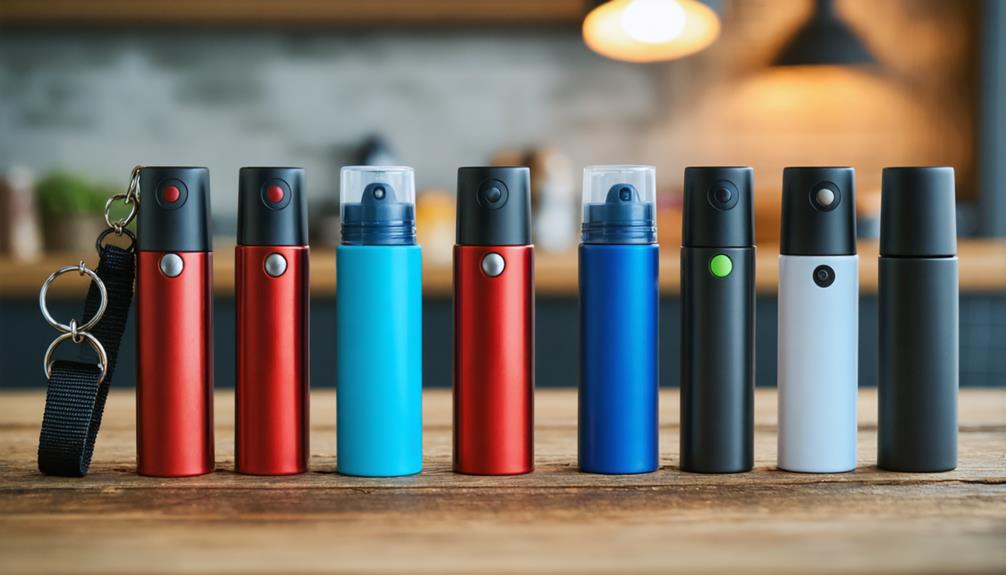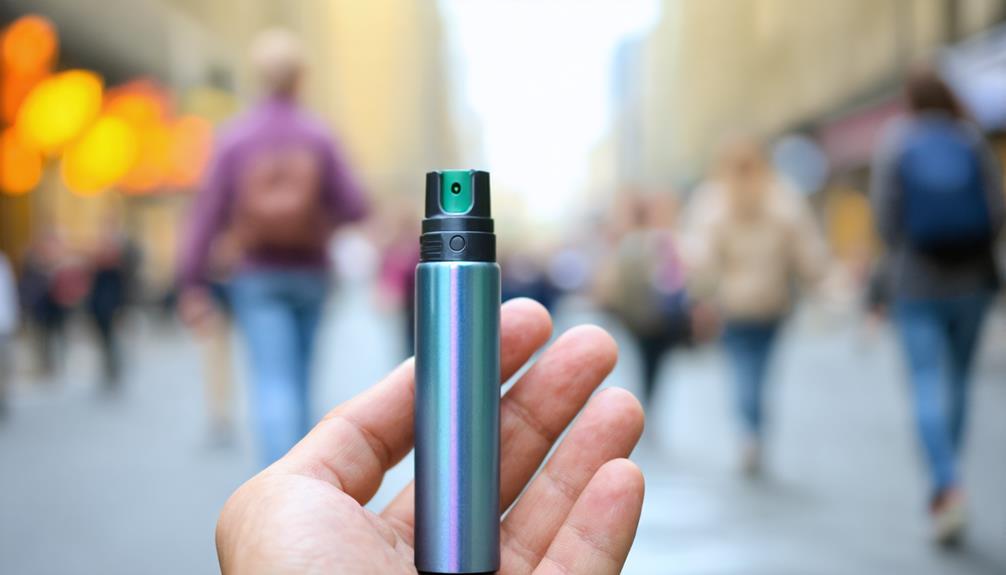
Brainstorm Security Shop

For Orders Over $199

On Any Of Our Products

Details On Refund Page
Pocket pepper spray has emerged as a quintessential self-defense tool, known for its portability and effectiveness. Its unobtrusive design allows it to fit seamlessly into daily life, whether clipped to a keychain or nestled in a handbag. However, beyond its convenience lies a complex web of considerations, including varying legal restrictions and the nuances of proper usage. As more individuals seek reassurance in uncertain environments, the role of pocket pepper spray in personal safety prompts critical questions. How does one choose the most suitable variant, and what are the essential guidelines for its use?
When it comes to personal safety, pocket pepper spray stands out as a popular and effective tool for self-defense. Its compact design makes it an ideal choice for individuals seeking a discreet yet powerful means of protection.
Pocket size pepper sprays are specifically designed to be easily carried, often fitting comfortably in a purse, pocket, or even attached to a keychain. This accessibility ensures that the spray is within reach when needed most, offering peace of mind in potentially threatening situations.
Understanding the different spray types available is crucial for selecting the most suitable option for personal use. The most common spray types include stream, fog, gel, and foam.
Stream sprays deliver a targeted, narrow stream of pepper solution, reducing the risk of wind blowback and making them effective in outdoor environments. Fog sprays, on the other hand, cover a wider area and can incapacitate multiple assailants, but may be prone to wind interference.
Gel sprays adhere to the target, minimizing the risk of affecting bystanders, while foam sprays expand upon contact, providing a visual marker on the attacker. Each type offers distinct advantages, emphasizing the importance of choosing based on individual needs and potential scenarios.
Carrying pepper spray offers several significant advantages for personal safety and peace of mind. As an effective self-defense tool, pepper spray serves as a practical deterrent against potential threats, providing individuals with a non-lethal method to protect themselves.
Its compact size and ease of use make it a popular choice for those seeking to enhance their personal safety without the need for extensive training or physical strength. By temporarily incapacitating an attacker, pepper spray allows the user crucial moments to escape and seek help, thus reducing the risk of harm.
Incorporating pepper spray into one’s self-defense strategies is a prudent decision, particularly in environments where personal security may be compromised. It acts as a reliable first line of defense, bridging the gap between feeling vulnerable and being empowered to take control of one’s safety.
Additionally, the psychological impact of simply possessing pepper spray can boost an individual’s confidence, knowing they have a means to defend themselves if necessary. This empowerment contributes to a heightened sense of security, which is invaluable in today’s world.
Ultimately, pepper spray is a versatile and accessible tool that supports an individual’s right to personal safety and offers reassurance in uncertain situations.

Selecting an appropriate pepper spray is an important step in ensuring personal safety and maximizing the benefits discussed previously. When choosing the right pepper spray, two critical factors to consider are spray strength and nozzle type.
Spray strength, often measured by the concentration of oleoresin capsicum (OC), directly impacts the spray’s effectiveness. Higher concentrations generally offer more potent deterrence capabilities, but it is essential to balance potency with safety to prevent unintended harm to oneself or others.
Nozzle type is another crucial consideration. The nozzle determines the spray pattern, which can range from a stream, cone, fog, or gel. Each pattern has distinct advantages: a stream generally offers a longer range and is less affected by wind, while a cone or fog can cover a wider area, making it easier to hit the target.
Gel-based sprays adhere better to the target, reducing the risk of blowback. Understanding these differences will help you choose a nozzle type that best suits your environment and personal safety needs.
Understanding the legal considerations surrounding pepper spray is essential for responsible ownership and use. Legal restrictions vary significantly across jurisdictions, affecting the possession, purchase, and deployment of pepper spray. Familiarity with self-defense laws is crucial, as improper use may lead to legal consequences. In certain areas, pepper spray is considered a controlled substance, requiring permits for carrying it. Other regions might impose size or formulation restrictions, emphasizing the importance of understanding local laws.
Below is a summary of some legal considerations across different regions:
| Region | Legal Restrictions | Self-Defense Law Notes |
|---|---|---|
| California | Permit required for over 2.5 oz | Self-defense permissible |
| New York | Sale restricted to pharmacies | Justifiable use in self-defense |
| Michigan | Max concentration: 10% OC | Reasonable threat assessment needed |
| Massachusetts | Requires Firearms ID card | Use in proportionate response only |
| Illinois | Minors prohibited from carrying | Legal only in immediate threats |
Understanding the framework of self-defense laws is paramount. These laws dictate when and how pepper spray can be utilized without legal repercussions. It’s important to note that misuse or unwarranted aggression with pepper spray can lead to criminal charges. Consequently, being informed about legal restrictions and self-defense laws ensures that individuals remain compliant while protecting themselves effectively.

When considering the safe use of pocket pepper spray, it is essential to focus on proper handling techniques to ensure both effectiveness and personal safety.
Understanding the effective spray distance is crucial, as it maximizes the device’s defensive capabilities while minimizing the risk of self-exposure.
Additionally, strategic storage and accessibility are key factors that can significantly impact the speed and ease of deployment in emergency situations.
Ensuring the safe and effective use of pocket pepper spray requires a thorough understanding of proper handling techniques. Users must first familiarize themselves with the various spray types available, as each type offers distinct benefits and requires different deployment techniques.
The most common spray types include stream, cone, and fogger. Stream sprays allow for precision targeting with minimal blowback risk, making them suitable for outdoor use. Cone sprays, on the other hand, disperse a wider pattern, increasing the likelihood of contact with the target, while foggers deliver a mist that envelops the immediate area for maximum coverage.
Once the appropriate spray type is selected, understanding deployment techniques is crucial. Users should practice holding the canister firmly in their dominant hand, ensuring a secure grip. The thumb should be positioned on the trigger, ready for quick activation.
In practice scenarios, aim for the target’s face, particularly the eyes, while maintaining a safe distance to reduce self-exposure. Additionally, it is vital to keep the arm extended to maximize the reach and control of the spray.
Regular practice of these techniques enhances muscle memory, enabling a prompt response in high-stress situations. Proper handling ensures both safety and efficacy in defensive situations.
Determining the effective spray distance is crucial for the safe and successful use of pocket pepper spray. The spray range typically varies from 6 to 12 feet, depending on the brand and formulation. Understanding this range allows users to maintain a safe distance from potential threats while ensuring that the spray reaches the target effectively.
Positioning oneself within the optimal spray range is vital for both safety and efficacy, as a distance too short might increase exposure to the spray’s effects, while a distance too long might diminish its potency.
Environmental conditions, particularly wind factors, play a significant role in the effective use of pepper spray. Wind can alter the direction and reach of the spray, potentially causing it to miss the target or blow back towards the user.
It is advisable to remain aware of wind direction and speed when deploying pepper spray, adjusting your position if necessary to avoid unintended exposure. Practicing with an inert training spray can help users develop the skills needed to account for these environmental variables.
Ultimately, understanding the effective spray distance and considering wind factors are essential steps in ensuring the safe and effective use of pocket pepper spray.
Properly storing and ensuring easy accessibility of pocket pepper spray are critical components of its safe usage. The effectiveness of pepper spray for self-defense relies significantly on how it is carried and stored. Selecting appropriate carrying methods can enhance both safety and readiness, allowing for quick access when needed.
Individuals should consider diverse storage options to align with personal lifestyle and daily activities, ensuring that the spray is both secure and readily available.
Here are some effective carrying methods for pocket pepper spray that promote safety and accessibility:
Ultimately, the key to effective pepper spray use is maintaining a balance between secure storage and rapid deployment, ensuring it is both a practical and reliable defense tool.
Maintaining and storing pocket pepper spray correctly is crucial for ensuring its reliability and effectiveness in critical situations. One of the primary aspects of maintenance is keeping track of spray expiration dates. Over time, the chemical components in pepper spray can degrade, reducing their potency and reliability. Therefore, checking the expiration date regularly and replacing the canister as needed is essential to ensure it functions optimally when required.
In addition to monitoring expiration dates, regular nozzle cleaning is important to prevent clogging, which could impede the spray’s performance. A clogged nozzle can render the device useless in emergencies, so periodic inspection and cleaning with a soft cloth or a gentle brush can help maintain its functionality.
Proper storage of pocket pepper spray also plays a vital role in its maintenance. It is advisable to store the device in a cool, dry place, away from direct sunlight and extreme temperatures, which can compromise the integrity of the canister.
Additionally, keeping the spray in an accessible yet secure location ensures it is readily available for use while minimizing the risk of accidental discharge. By adhering to these maintenance and storage practices, users can maximize the effectiveness and reliability of their pocket pepper spray.
In addressing self-defense effectiveness during unexpected animal encounters, it’s essential to evaluate deterrent tools. Certain spray products may offer temporary protection, but effectiveness can vary based on the animal species and product specifications.
Pepper spray effectiveness and duration can vary, generally causing discomfort for 20 to 90 minutes. The immediate impact includes intense irritation, with effects gradually diminishing, depending on factors like spray concentration and the individual’s sensitivity.
Inquiring about carrying pepper spray on airplanes necessitates understanding legal restrictions and travel regulations. Generally, it is prohibited in carry-on luggage, though regulations may vary by airline and destination, emphasizing the importance of verifying specific guidelines prior to travel.
Pepper spray does have expiration indicators, typically found on the canister’s label. Proper storage recommendations include keeping it in a cool, dry place to ensure efficacy, with most products expiring three to four years after manufacture.
Pepper spray can lead to significant eye safety concerns and cause severe skin irritation. Although generally temporary, exposure may result in prolonged discomfort; however, it rarely causes permanent damage to eyes or skin under standard usage conditions.
Pocket pepper spray serves as a practical self-defense tool, enhancing personal safety through its compact design and effectiveness in deterring potential threats. Its various types, such as stream, gel, and fog, offer flexibility in choice to suit individual needs. Understanding local legal regulations and adhering to safe handling practices are crucial for responsible use. Proper maintenance and storage further ensure reliability, making pocket pepper spray an essential accessory for those seeking increased security in daily life.

Brainstorm Security Shop
1867 Caravan Trail
Ste 105
Jacksonville, FL 32216
Call us toll free: (800) 859-5566